Consistent with the trending cycles observed in the last chapter of this series, after a brief period of post-war prosperity – and indulgence, the pendulum of our topic subject began to swing back in the animated world toward the more natural interest in keeping slim and trim – at least to the point of removing those excess pounds packed away from a few years of slacking off. Overeating would still make the screen from time to time – but would be more frequently cast as an object lesson of what not to do than as a desirable goal, or at least frameworked in the setting of a world where exercise was an alternative. So snap on those headbands, don your athletic shorts and best running shoes, and get set for some energetic roadwork down our latest animation trail, as we sweat away the lard and try to squeeze into that size 36 or so that used to fit so well not so long ago.

Bye Bye Bluebeard (Warner, Porky Pig, 10/21/49 – Arthur Davis, dir.) – Porky Pig on an exercise kick? Well, it almost happened here, although slightly misinterpreted. Our story opens with a radio broadcast, returning to the original theme explored in Part 1 of this series of the morning radio exercise program. Its latest listener is Porky, who waits at the ready for the commencement of the announcer’s instructions. “Shall we have a go at it?” the announcer asks/ Porky nods eagerly, following the warm up instructions, “Arms out. Chest up. Chin in.” The rhythmic chant for the maneuver begins: “In, up, out, down. In, up, out, down.” There’s just one tiny, little, insignificant detail wrong. Porky has interpreted these instructions not as the movements intended for any specific part of his body, but as those for the directing of his fork at the dinner table! The result has him packing away mouthful after mouthful of rich food piled high at the table, using the “Little Audrey” technique seen last week of a fork for each hand – no meed for finessing with a knife or spoon.
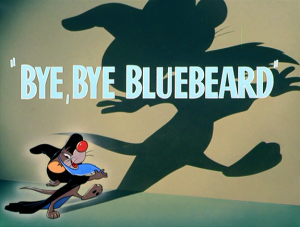 Amidst this pleasing domestic scene rises the shadow of an intruder – a moving flower vase, that steals upon Porky’s food stash, drills a hole out of the vase’s side, and attempts to build a sandwich with items from the table, accidentally adding Porky’s finger as the sandwich’s principal ingredient. “YEOW!”, yells Porky, as unseen jaws inside the vase chomp down upon his extended digit. He smashes the vase, revealing a return for what appears to be the mouse who first pestered Porky in Art Davis’s debut film for Warner, “Mouse Menace”. The somewhat embarrassed rodent smiles a sheepish grin, with Porky’s finger still clenched between its teeth, then beats a hasty retreat.into the mousehole, narrowly dodging a semicircle of blades of what appears to be the entire knife content of Porky’s place settings from the table. But this may not be the only unexpected company Porky will have today, as the radio broadcast is interrupted with a news flash that Bluebeard the killer is at large, and to take every precaution for your safety. With amazing speed for an overweight pig, Porky zooms around the house to bolt and nail every window, and barricade the front door with furniture, chains and padlocks piled about four feet thick. In spite of all these precautions, a sinister robed shadow of a bearded figure wielding a knife appears on the wall, accompanied by am equally menacing laugh. Porky is so scared, his sheet-white ghost pops our of a flip-top opening in his head, then drops back inside, as the horrifying figure of Bluebeard enters the scene – standing only three inches high? It is of course, the mouse in disguise. Porky is attempting to climb the walls, as the mouse sharpens a table knife with apparent thoughts of doing Porky in. “You can have anything you want”, Porky appeases, offering, “H-how about a nice thick steak?” The mouse smiles a broad smile to the camera, and repeats his sinister laugh in a quite satisfied fashion, as his plan works to perfection.
Amidst this pleasing domestic scene rises the shadow of an intruder – a moving flower vase, that steals upon Porky’s food stash, drills a hole out of the vase’s side, and attempts to build a sandwich with items from the table, accidentally adding Porky’s finger as the sandwich’s principal ingredient. “YEOW!”, yells Porky, as unseen jaws inside the vase chomp down upon his extended digit. He smashes the vase, revealing a return for what appears to be the mouse who first pestered Porky in Art Davis’s debut film for Warner, “Mouse Menace”. The somewhat embarrassed rodent smiles a sheepish grin, with Porky’s finger still clenched between its teeth, then beats a hasty retreat.into the mousehole, narrowly dodging a semicircle of blades of what appears to be the entire knife content of Porky’s place settings from the table. But this may not be the only unexpected company Porky will have today, as the radio broadcast is interrupted with a news flash that Bluebeard the killer is at large, and to take every precaution for your safety. With amazing speed for an overweight pig, Porky zooms around the house to bolt and nail every window, and barricade the front door with furniture, chains and padlocks piled about four feet thick. In spite of all these precautions, a sinister robed shadow of a bearded figure wielding a knife appears on the wall, accompanied by am equally menacing laugh. Porky is so scared, his sheet-white ghost pops our of a flip-top opening in his head, then drops back inside, as the horrifying figure of Bluebeard enters the scene – standing only three inches high? It is of course, the mouse in disguise. Porky is attempting to climb the walls, as the mouse sharpens a table knife with apparent thoughts of doing Porky in. “You can have anything you want”, Porky appeases, offering, “H-how about a nice thick steak?” The mouse smiles a broad smile to the camera, and repeats his sinister laugh in a quite satisfied fashion, as his plan works to perfection.
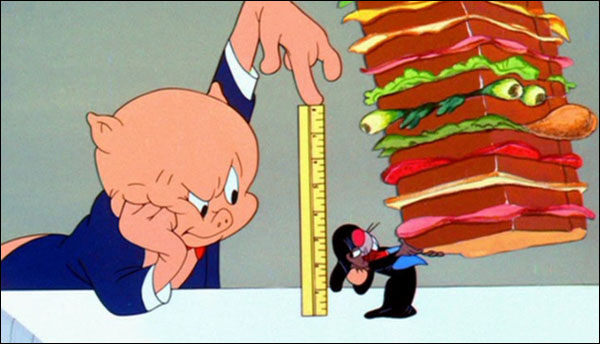
Now Porky is waiting on the mouse hand and foot, as the rodent assumes Porky’s place at the dinner table. Darting back into the kitchen for some “chanpag – g – g, some wine”, Porky hears another news flash, providing a description of Bluebeard – 350 pounds , and height of 6 feet, eleven inches! A quick measurement with a ruler tells Porky definitively that his “killer” does not match the description. The mouse’s cover blown, he retreats again, but Porky appears to have caught him by the fake costume beard under the tablecloth. Porky tugs at the beard to pull the intruder out. However, the effort seems unusually intense for just a scrawny mouse’s weight, and while Porky trudges forward away from the table, he does not see the reveal of the beard’s owner – the real Bluebeard, in the flesh. When the mouse appears before him, pointing Porky’s attention to who is behind him, Bluebeard stands up, creatively bearing ruler markings on his person, indicating his precise height measurement at six feet, eleven inches. Porky turns solid white, and keels backward in a faint.
 Bluebeard ties Porky to a small rocket aimed at space, lights the fuse, then seats himself at the table to chow down. (Everybody’s hungry in this picture!) The mouse, still in costume, attempts to get a share for himself, pretending to be Bluebeard’s little conscience from inside him. But Bliebeard is not fooled, inquiring, “Well, what are you doing outside?” The mouse avoids being swallowed by dousing himself in tabasco sauce, then leads Bluebeard on a merry chase around the dinner table, finally making it to the safety of the mousehole. Meanwhile, Porky manages to tug out the mile-long fuse from the rocket with one hand, saving himself from a non-scheduled flight. Bluebeard takes out his frustrations on Porky, tying the pig to a chair, while he constructs from components appearing from nowhere a guillotine. The mouse, witnessing these events, paces back in forth within the mousehole, debating whether any action is called for or worth bothering about. He decides the issue by the 50-50 chance of flipping a coin, and, presumably losing the toss, turns heroic. He parades in front of Bluebird in a chef’s hat, ringing a dinner bell, then returns with a covered dinner tray. Bluebeard lifts the lid, revealing a tray full of lighted black bombs. The gullible Bluebeard mistakes these treats for “Popovers!”, and ravenously consumes the entire contents. His stomach begins to vibrate threateningly, and smoke rises from his lips. Bluebeard races to the medicine cabinet, attempting to mix himself a home-made bicarbonate, and is just lifting the glass to quench the internal flames – when he explodes. The final scene returns to where the picture began, the next morning. Porky again engages happilt in the “In, ip, out, down” exercise. But to his right, a new miniature table has been set out for the rodent, also piled high with food – and the mouse matches Porky for every move of the “exercise”, gobbling away at his own feast. The mouse pulls back the tablecloth from his tummy, revealing that he has now grown a huge pot belly which extends under the table, which he happily pats for the iris out.
Bluebeard ties Porky to a small rocket aimed at space, lights the fuse, then seats himself at the table to chow down. (Everybody’s hungry in this picture!) The mouse, still in costume, attempts to get a share for himself, pretending to be Bluebeard’s little conscience from inside him. But Bliebeard is not fooled, inquiring, “Well, what are you doing outside?” The mouse avoids being swallowed by dousing himself in tabasco sauce, then leads Bluebeard on a merry chase around the dinner table, finally making it to the safety of the mousehole. Meanwhile, Porky manages to tug out the mile-long fuse from the rocket with one hand, saving himself from a non-scheduled flight. Bluebeard takes out his frustrations on Porky, tying the pig to a chair, while he constructs from components appearing from nowhere a guillotine. The mouse, witnessing these events, paces back in forth within the mousehole, debating whether any action is called for or worth bothering about. He decides the issue by the 50-50 chance of flipping a coin, and, presumably losing the toss, turns heroic. He parades in front of Bluebird in a chef’s hat, ringing a dinner bell, then returns with a covered dinner tray. Bluebeard lifts the lid, revealing a tray full of lighted black bombs. The gullible Bluebeard mistakes these treats for “Popovers!”, and ravenously consumes the entire contents. His stomach begins to vibrate threateningly, and smoke rises from his lips. Bluebeard races to the medicine cabinet, attempting to mix himself a home-made bicarbonate, and is just lifting the glass to quench the internal flames – when he explodes. The final scene returns to where the picture began, the next morning. Porky again engages happilt in the “In, ip, out, down” exercise. But to his right, a new miniature table has been set out for the rodent, also piled high with food – and the mouse matches Porky for every move of the “exercise”, gobbling away at his own feast. The mouse pulls back the tablecloth from his tummy, revealing that he has now grown a huge pot belly which extends under the table, which he happily pats for the iris out.
You can watch the cartoon online at B98.TV
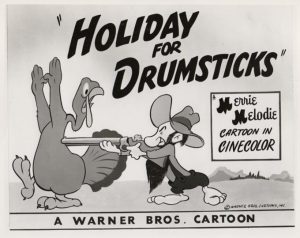 Holiday for Drumsticks (Warner, Daffy Duck, 1/22/49 – Arthur Davis, dir.) – Thanksgiving is nearing, and a hillbilly couple (between shots exchanged in a feud with theur neighbors) have acquired a live turkey, intended for the holiday feast. The turkey becomes the honored guest and new tenant of the poultry enclosure behind their home. However, there is already a resident here – Daffy Duck, who views the bird as just more competition for the meager supply of food provided in this dump. However, Daffy at least relies on the fact that he has seniority, and assumes the stranger won’t get any more food than he does. Daffy’s eyes bulge out, however, when a banquet table is set before the turkey to fatten him up. Knowing he has to get in on this action, Daffy interrupts his new neighbor before he can lift a fork to his beak. “Hold it, Thomas!” Daffy shrieks. “Boy, am I glad I was in time to save you.” “Save me from what?”, asks the turkey. “This food”, responds Daffy. Daffy spins the tale of the humans’ little game, saying he’s “seen ‘em come and I’ve seen em’ go” with first the fattening up, then the carving on the dinner table. His story sends the turkey into trembling jitters, climbing a tree in attempt to escape his fate. Daffy suggests that the solution is to fool them, by not eating. Hopping on the turkey’s stomach, Daffy observes that the turkey also better think about reducing, as he already weighs too much now. To demonstrate, Daffy drags the turkey over to a conveniently accessible coin-operated weight scale (except, instead of merely placing the turkey ipon it, Daffy adds his own foot to double the weight reading). The scale reads a whopping 200 pounds (is this possible?), adding a fortune readout – “You will soon be surrounded by friends and cranberries.”
Holiday for Drumsticks (Warner, Daffy Duck, 1/22/49 – Arthur Davis, dir.) – Thanksgiving is nearing, and a hillbilly couple (between shots exchanged in a feud with theur neighbors) have acquired a live turkey, intended for the holiday feast. The turkey becomes the honored guest and new tenant of the poultry enclosure behind their home. However, there is already a resident here – Daffy Duck, who views the bird as just more competition for the meager supply of food provided in this dump. However, Daffy at least relies on the fact that he has seniority, and assumes the stranger won’t get any more food than he does. Daffy’s eyes bulge out, however, when a banquet table is set before the turkey to fatten him up. Knowing he has to get in on this action, Daffy interrupts his new neighbor before he can lift a fork to his beak. “Hold it, Thomas!” Daffy shrieks. “Boy, am I glad I was in time to save you.” “Save me from what?”, asks the turkey. “This food”, responds Daffy. Daffy spins the tale of the humans’ little game, saying he’s “seen ‘em come and I’ve seen em’ go” with first the fattening up, then the carving on the dinner table. His story sends the turkey into trembling jitters, climbing a tree in attempt to escape his fate. Daffy suggests that the solution is to fool them, by not eating. Hopping on the turkey’s stomach, Daffy observes that the turkey also better think about reducing, as he already weighs too much now. To demonstrate, Daffy drags the turkey over to a conveniently accessible coin-operated weight scale (except, instead of merely placing the turkey ipon it, Daffy adds his own foot to double the weight reading). The scale reads a whopping 200 pounds (is this possible?), adding a fortune readout – “You will soon be surrounded by friends and cranberries.”
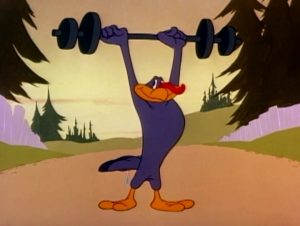 Training begins, with only 16 days until Thanksgiving. The turkey performs rowing exercises in a water trough, while Daffy consumes a fruit cornucopia while reclining in a lounge chair, barking orders as a personal motivational coach. The turkey skips rope, while Daffy threads together the kernels off corn cobs for easy consumption. The turkey runs miles on a treadmill, while Daffy consumes a table full of pies and cakes (using the old gag of carving out one slice, then eating the four-fifths of a pie that’s left). The turkey lifts a barbell above his head, then sinks into the dirt on which he is standing, while Daffy rests in a hammock, devousing a mountain of sandwiches beside him. The turkey takes on pole vaulting, only to crash headfirst into the bar. From the stars emanating from his head, a creative montage is presented, depicting contrasting images of the turkey’s and duck’s progress in respective appearing circular screens, set against a blue background with flying calendar dates. Against Carl Stalling’s rapid-fire musical rendition of “Freddie the Freshman”, the turkey endures road work, chin-ups, and cycling, while Daffy consumes barrels of apples, and tables of corn. The montage ends as the date of Thanksgiving flashes before us in the screen. Daffy is still at the dinner table, reprising Davis’s closing gag from “Bye Bye Bluebeard”, with his stomach at first hidden under the tablecloth, then revealed to rank him amonf the super-obese. He belches a loud burp, then modestly asks the audience to excuse him. On ther side of the yard, the turkey emerges from a steam cabinet (ejected like a pop-up toaster), physically exhausted, but with a midriff reduced to a pencil line. “What a wreck”, asides Daffy to the audience, assuring the turkey that nobody would eat him now. His prediction is correct, as the hillbilly husband arrives with his axe, only to conclude that the turkey “don’t look very healthy.” “Yeah, ain’t he a mess?”, observes Daffy. Then, boastful of his record-breaking physique, Daffy begins showing off to the hillbilly what a healthy poultry specimen is supposed to look like, emphasizing the width of his wings and drumsticks. “Too bad ya can’t eat duck on Thanksgiving”, Daffy chuckles. But the idea has just been planted in the mind of his owner, who brightens with a toothy grin. Realization sets in, as Daffy gulps, and again asides to the audience, “Or can ya?”
Training begins, with only 16 days until Thanksgiving. The turkey performs rowing exercises in a water trough, while Daffy consumes a fruit cornucopia while reclining in a lounge chair, barking orders as a personal motivational coach. The turkey skips rope, while Daffy threads together the kernels off corn cobs for easy consumption. The turkey runs miles on a treadmill, while Daffy consumes a table full of pies and cakes (using the old gag of carving out one slice, then eating the four-fifths of a pie that’s left). The turkey lifts a barbell above his head, then sinks into the dirt on which he is standing, while Daffy rests in a hammock, devousing a mountain of sandwiches beside him. The turkey takes on pole vaulting, only to crash headfirst into the bar. From the stars emanating from his head, a creative montage is presented, depicting contrasting images of the turkey’s and duck’s progress in respective appearing circular screens, set against a blue background with flying calendar dates. Against Carl Stalling’s rapid-fire musical rendition of “Freddie the Freshman”, the turkey endures road work, chin-ups, and cycling, while Daffy consumes barrels of apples, and tables of corn. The montage ends as the date of Thanksgiving flashes before us in the screen. Daffy is still at the dinner table, reprising Davis’s closing gag from “Bye Bye Bluebeard”, with his stomach at first hidden under the tablecloth, then revealed to rank him amonf the super-obese. He belches a loud burp, then modestly asks the audience to excuse him. On ther side of the yard, the turkey emerges from a steam cabinet (ejected like a pop-up toaster), physically exhausted, but with a midriff reduced to a pencil line. “What a wreck”, asides Daffy to the audience, assuring the turkey that nobody would eat him now. His prediction is correct, as the hillbilly husband arrives with his axe, only to conclude that the turkey “don’t look very healthy.” “Yeah, ain’t he a mess?”, observes Daffy. Then, boastful of his record-breaking physique, Daffy begins showing off to the hillbilly what a healthy poultry specimen is supposed to look like, emphasizing the width of his wings and drumsticks. “Too bad ya can’t eat duck on Thanksgiving”, Daffy chuckles. But the idea has just been planted in the mind of his owner, who brightens with a toothy grin. Realization sets in, as Daffy gulps, and again asides to the audience, “Or can ya?”
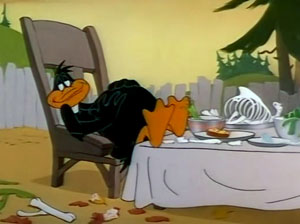 Exchanging his axe for his rifle, the hillbilly takes his first pot-shot at Daffy. Set to the world’s fastest musical rendition of “The Arkansas Traveller”, a wild chase begins at breakneck speed. “I gotta lose this weight, but fast”, says Daffy, attempting to employ each of the turkey’s exercise devices while dodging buckshot. Daffy swings at a punching bag, but the hillbilly’s shot deflates it of sawdust. Daffy lifts a barbell, but the hillbilly’s shot breaks the center of the bar in two, dragging Daffy’s arms to the ground by the two respective weights. Daffy jumps into the reducing cabinet. But another bullet punctures the cabinet’s side, causing the cabinet to reduce instead of the duck, shrinking to a small box around the duck’s neck. Out of exercise ideas. Daffy pleads to his old “pal”, the ttirkey, for help. But the turkey has now wised up to Daffy’s game, and uses the opportunity to force Daffy into a series of painful and futile hiding places (a bit lifted entirely from Chuck Jones’s previous 1940’s Thanksgiving epic, “Tom Turk and Daffy”). After running Daffy through the proverbial mill, the turkey concludes, ”Look,.you had bettter leave the country. Go to Rio where they don’t have Thanksgiving.” The turkey supplies Daffy with a bag and tickets, telling him to hurry so he doesn’t miss the boat. He ushers the dazed duck into the house, where the hillbilly couple have been let in on the turkey’s plan, and are dressed in sailor hats, standing in a salute, with a gangplank raised to the doorway of their pot-bellied stove, labelled as boat to Rio De Janiero. Daffy climbs in, and the door is closed upon him. “Inside state room. I’ll have to talk to the steward”, he mumbles to himself. A few hours tick by, and paw hillbilly, patiently waiting at the dinner table, asks if the bird is done yet. “No, and it don’t look like it ever will be.” Demonstrating the problem, as Daffy periodically sticks his head out of the stove grating, the hillbilly woman states, “I keep a-lightin’ the matches and he keeps a-blowin’ them out.”
Exchanging his axe for his rifle, the hillbilly takes his first pot-shot at Daffy. Set to the world’s fastest musical rendition of “The Arkansas Traveller”, a wild chase begins at breakneck speed. “I gotta lose this weight, but fast”, says Daffy, attempting to employ each of the turkey’s exercise devices while dodging buckshot. Daffy swings at a punching bag, but the hillbilly’s shot deflates it of sawdust. Daffy lifts a barbell, but the hillbilly’s shot breaks the center of the bar in two, dragging Daffy’s arms to the ground by the two respective weights. Daffy jumps into the reducing cabinet. But another bullet punctures the cabinet’s side, causing the cabinet to reduce instead of the duck, shrinking to a small box around the duck’s neck. Out of exercise ideas. Daffy pleads to his old “pal”, the ttirkey, for help. But the turkey has now wised up to Daffy’s game, and uses the opportunity to force Daffy into a series of painful and futile hiding places (a bit lifted entirely from Chuck Jones’s previous 1940’s Thanksgiving epic, “Tom Turk and Daffy”). After running Daffy through the proverbial mill, the turkey concludes, ”Look,.you had bettter leave the country. Go to Rio where they don’t have Thanksgiving.” The turkey supplies Daffy with a bag and tickets, telling him to hurry so he doesn’t miss the boat. He ushers the dazed duck into the house, where the hillbilly couple have been let in on the turkey’s plan, and are dressed in sailor hats, standing in a salute, with a gangplank raised to the doorway of their pot-bellied stove, labelled as boat to Rio De Janiero. Daffy climbs in, and the door is closed upon him. “Inside state room. I’ll have to talk to the steward”, he mumbles to himself. A few hours tick by, and paw hillbilly, patiently waiting at the dinner table, asks if the bird is done yet. “No, and it don’t look like it ever will be.” Demonstrating the problem, as Daffy periodically sticks his head out of the stove grating, the hillbilly woman states, “I keep a-lightin’ the matches and he keeps a-blowin’ them out.”
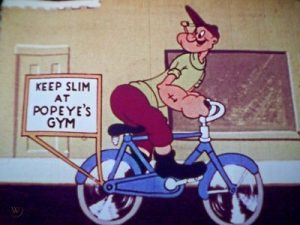 Gym Jam (Paramount/Famous, Popeye, 3/17/50 – I. Sparber, dir.) – Essentially, a Technicolor remake of Fleischer’s Vim, Vigor, and Vitaliky, reviewed in chapter 1 of this series – with some elements of Never Kick a Woman, also reviewed in Chapter 1, thrown in. This time (no doubt to save on the animation budget), Olive appears to be Popeye’s only student at his gym. (I hope her fee is enough to pay the rent.) Bluto does not run the night club next door, but just happens to be a tough guy on the street corner, who takes a shine to Olive as his personal “angel” as she passes performing road work behind Popeye’s bicycle. As Bluto grabs her away for a kiss, chasing Olive up a lamp pole, Popeye delivers Bluto a first sock into the trash, pulling Olive away into the safety of the gym. Bluto repeats his guise of posing as a lady pupil, while Olive becomes increasingly jealous, taking out her frustrations on the punching bag as in Never Kick a Woman. Bluto reprises his style of destructive competition with Popeye on chinups, Indian clubs, exercise bicycle and barbells, finally locking Popeye in a steam cabinet, unconscious, with the steam setting on the meter reading, “That’s all brother”. Olive is again pursued when Bluto’s wig is flipped, and again winds up straddling the suspended acrobatic rings with her feet. Bluto cuts one of the ropes holding up the rings, flipping Olive into a basketball hoop, from which Bluto pulls her, holding her above his head balanced on her hands. Bluro extends his arms while holding onto Olive’s hands, drawing her toward him in the manner of collapsing a telephone extender, and stealing kiss after kiss. Popeye finally revives, escaping from the steam cabinet, at a reduced height of only about five inches tall. But of course, his spinach can is nearby, into which Popeye dives. A few munches, and Popeye is his old self, with his forearm converted to a 5,000 pound weight. One single sock compresses Bluto into the shape of a dumb bell, causing him to neatly fit upon a rack of the genuine articles. Now it is Olive who holds Popeye over her head, using the same arm maneuver as Bluto to draw Popeye close for repeated kisses. “Don’t. Stop”, gently protests Popeye. But his calls soon change to “Don’t stop. Don’t stop. Don’t stop!”
Gym Jam (Paramount/Famous, Popeye, 3/17/50 – I. Sparber, dir.) – Essentially, a Technicolor remake of Fleischer’s Vim, Vigor, and Vitaliky, reviewed in chapter 1 of this series – with some elements of Never Kick a Woman, also reviewed in Chapter 1, thrown in. This time (no doubt to save on the animation budget), Olive appears to be Popeye’s only student at his gym. (I hope her fee is enough to pay the rent.) Bluto does not run the night club next door, but just happens to be a tough guy on the street corner, who takes a shine to Olive as his personal “angel” as she passes performing road work behind Popeye’s bicycle. As Bluto grabs her away for a kiss, chasing Olive up a lamp pole, Popeye delivers Bluto a first sock into the trash, pulling Olive away into the safety of the gym. Bluto repeats his guise of posing as a lady pupil, while Olive becomes increasingly jealous, taking out her frustrations on the punching bag as in Never Kick a Woman. Bluto reprises his style of destructive competition with Popeye on chinups, Indian clubs, exercise bicycle and barbells, finally locking Popeye in a steam cabinet, unconscious, with the steam setting on the meter reading, “That’s all brother”. Olive is again pursued when Bluto’s wig is flipped, and again winds up straddling the suspended acrobatic rings with her feet. Bluto cuts one of the ropes holding up the rings, flipping Olive into a basketball hoop, from which Bluto pulls her, holding her above his head balanced on her hands. Bluro extends his arms while holding onto Olive’s hands, drawing her toward him in the manner of collapsing a telephone extender, and stealing kiss after kiss. Popeye finally revives, escaping from the steam cabinet, at a reduced height of only about five inches tall. But of course, his spinach can is nearby, into which Popeye dives. A few munches, and Popeye is his old self, with his forearm converted to a 5,000 pound weight. One single sock compresses Bluto into the shape of a dumb bell, causing him to neatly fit upon a rack of the genuine articles. Now it is Olive who holds Popeye over her head, using the same arm maneuver as Bluto to draw Popeye close for repeated kisses. “Don’t. Stop”, gently protests Popeye. But his calls soon change to “Don’t stop. Don’t stop. Don’t stop!”
 Jerry’s Cousin (MGM, Tom and Jerry, 4/7/51 – William Hanna/Joseph Barbera, dir.) – Introducing what may have been the first of Jerry’s family relations – “Muscles” Mouse, a look-alike to Jerry, but with a decidedly different attitude and persona. Muscles is the king of his domain – a tough city alley (named “Hogan’s Alley” – predicting the use of Hogie’s Alley for Top Cat), where he slaps around for pure fun any scraggily alley cat who happens to cross his path. Local felines are thrown into trash cams, smashed into telephone poles, and judo flipped by this miraculously-strong rodent who wo’t take guff from anyone who meows. Muscles’ mousehole even has an impressive score of fighter-pilot style “conformed” stamps of cats downed, painted alongside the hole’s doorway. The morning mail brings a desperate request for help from Jerry, noting “serious trouble” with Tom. Tom has taken up a new hobby – of lobbing lit firecrackers into Jerry’s hole, blasting apart the contents of his interior apartment. Muscles walks in to find one of these sizzling menaces thrown directly in his path. With barely a pause, he picks up the lighted weapon and marches out of the mousegole, where Tom waits with his fingers in his ears, anticipating the explosion. Muscles reaches up, yanks open Tom’s lower jaw, inserts the firecracker in Tom’s mouth, then hold Tom’s lips closed, as the blast occurs – inside Tom’s head. With an ultimatum to Tom never to try to mess around with his cousin, Muscles tosses Tom across the room, into a vase, then spits disdainfully at the vase, cracking it open to reveal Tom transformed into the shape and dimensions of the vase and its handles.
Jerry’s Cousin (MGM, Tom and Jerry, 4/7/51 – William Hanna/Joseph Barbera, dir.) – Introducing what may have been the first of Jerry’s family relations – “Muscles” Mouse, a look-alike to Jerry, but with a decidedly different attitude and persona. Muscles is the king of his domain – a tough city alley (named “Hogan’s Alley” – predicting the use of Hogie’s Alley for Top Cat), where he slaps around for pure fun any scraggily alley cat who happens to cross his path. Local felines are thrown into trash cams, smashed into telephone poles, and judo flipped by this miraculously-strong rodent who wo’t take guff from anyone who meows. Muscles’ mousehole even has an impressive score of fighter-pilot style “conformed” stamps of cats downed, painted alongside the hole’s doorway. The morning mail brings a desperate request for help from Jerry, noting “serious trouble” with Tom. Tom has taken up a new hobby – of lobbing lit firecrackers into Jerry’s hole, blasting apart the contents of his interior apartment. Muscles walks in to find one of these sizzling menaces thrown directly in his path. With barely a pause, he picks up the lighted weapon and marches out of the mousegole, where Tom waits with his fingers in his ears, anticipating the explosion. Muscles reaches up, yanks open Tom’s lower jaw, inserts the firecracker in Tom’s mouth, then hold Tom’s lips closed, as the blast occurs – inside Tom’s head. With an ultimatum to Tom never to try to mess around with his cousin, Muscles tosses Tom across the room, into a vase, then spits disdainfully at the vase, cracking it open to reveal Tom transformed into the shape and dimensions of the vase and its handles.
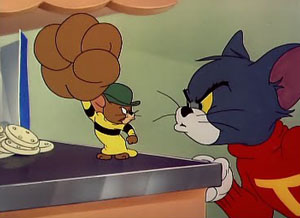 As with Sylvester in Hop, Look, and Listen, Tom engages in a hasty exercise plan to train for the main event. He vigorously raises barbells, and lifts huge metal weights. Finally, he is able to flex his arm muscles so high, they stretch upwards inside his monogrammed exercise sweater to raise the sweater’s waistline almost to under his chin. Tom marches over to confront Muscles, but his blow has little effect but to push Mescles’s derby hat down over his eyes. Muscles responds by blowing upon his thumb, which magically inflates his fist at least sevenfold. Another blow from Muscles, and Tom again flies backwards across the room, smashing his head into a cuckoo clock, the bird then seen protruding out of his mouth. By the end of the picture, Muscles has Tom command-trained to kiss his feet at the slightest whistle. And Jerry is given a twin set of sweater and derby matching Muscles’ outfit, so that when Jerry exits the mousehole in costume and whistles, Tom performs the same foot-kissing for Jerry, believing him to be his twin cousin – with such convincing result that Tom will even alternate which foot to kiss at Jerry’s whim. (The film, nominated foer an Academy Awatd, would become the nucleus of ideas for an update of the situation with an Asiatic mouse martial arts spwecialist assisting Pixie and Dixie, in the television episode “Judo Jack” for The Huckleberry Hound Show.).
As with Sylvester in Hop, Look, and Listen, Tom engages in a hasty exercise plan to train for the main event. He vigorously raises barbells, and lifts huge metal weights. Finally, he is able to flex his arm muscles so high, they stretch upwards inside his monogrammed exercise sweater to raise the sweater’s waistline almost to under his chin. Tom marches over to confront Muscles, but his blow has little effect but to push Mescles’s derby hat down over his eyes. Muscles responds by blowing upon his thumb, which magically inflates his fist at least sevenfold. Another blow from Muscles, and Tom again flies backwards across the room, smashing his head into a cuckoo clock, the bird then seen protruding out of his mouth. By the end of the picture, Muscles has Tom command-trained to kiss his feet at the slightest whistle. And Jerry is given a twin set of sweater and derby matching Muscles’ outfit, so that when Jerry exits the mousehole in costume and whistles, Tom performs the same foot-kissing for Jerry, believing him to be his twin cousin – with such convincing result that Tom will even alternate which foot to kiss at Jerry’s whim. (The film, nominated foer an Academy Awatd, would become the nucleus of ideas for an update of the situation with an Asiatic mouse martial arts spwecialist assisting Pixie and Dixie, in the television episode “Judo Jack” for The Huckleberry Hound Show.).
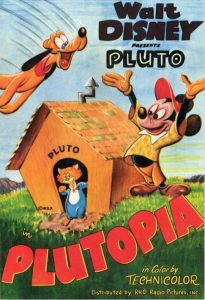 Plutopia (Disney/RKO, Pluto, 5/18/51 – Charles Nichols, dir.) – In an extended dream sequence, this film explores the imagination of Pluto, and the natural over-zealousness of appetite to which a dog might be prone. A weekend excursion to “Camp Utopia” with Mickey Mouse turns out to be anything but a Utopia for Pluto. A strict “No dogs allowed in cabins” rule lands the poor mutt on the outside looking in for the night. To make matters worse, and more humiliating, camp rules also require Pluto to remain at all times on a leash and muzzled. A passing cat manages to take full advantage of this situation, stealing away all the food left for Pluto on the cabin porch, placing it just outside the reach of his muzzled snout. The cat also hogs half of the space on the welcome mat as Pluto tries to settle down to sleep for the night. But in Pluto’s dreams, it is a different story. In a cloud-filled land of fire hydrants and doghouses (largely depicted in neon outline form against backgrounds of bare color), the cat, now developing the subservient voice of a manservant, becomes Pluto’s guide to the land of “Plutopia”, ready to wait upon the dog hand and foot, at his beck and call. Pluto does not know at first what to make of this, and simply reacts as an angry dog will – grabbing up the cat in his jaws, and flinging him around the room. To Pluto’s astonishment, the cat likes it! The cat races up a flight of stairs to reward Pluto with a dish of cream.
Plutopia (Disney/RKO, Pluto, 5/18/51 – Charles Nichols, dir.) – In an extended dream sequence, this film explores the imagination of Pluto, and the natural over-zealousness of appetite to which a dog might be prone. A weekend excursion to “Camp Utopia” with Mickey Mouse turns out to be anything but a Utopia for Pluto. A strict “No dogs allowed in cabins” rule lands the poor mutt on the outside looking in for the night. To make matters worse, and more humiliating, camp rules also require Pluto to remain at all times on a leash and muzzled. A passing cat manages to take full advantage of this situation, stealing away all the food left for Pluto on the cabin porch, placing it just outside the reach of his muzzled snout. The cat also hogs half of the space on the welcome mat as Pluto tries to settle down to sleep for the night. But in Pluto’s dreams, it is a different story. In a cloud-filled land of fire hydrants and doghouses (largely depicted in neon outline form against backgrounds of bare color), the cat, now developing the subservient voice of a manservant, becomes Pluto’s guide to the land of “Plutopia”, ready to wait upon the dog hand and foot, at his beck and call. Pluto does not know at first what to make of this, and simply reacts as an angry dog will – grabbing up the cat in his jaws, and flinging him around the room. To Pluto’s astonishment, the cat likes it! The cat races up a flight of stairs to reward Pluto with a dish of cream.
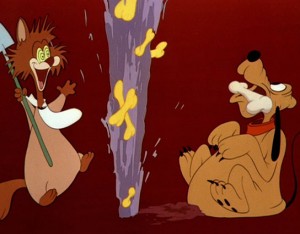 Testing out how things work in this new world, Pluto playfully trips the cat on the way down, causing the cream to be spilled. The cat reacts as if he has committed a cardinal sin, and begins to beat up upon himself to teach himself a lesson. But this is not enough for the cat, who insists that he must be punished, and for Pluto to bite him! Pluto thinks the idea is too silly to believe, and pushes the cat gently away. The cat, however, is so distraught that his master will not punish him, that he nearly commits suicide by holding a rifle barrel to his own head, which Pluto knocks away just before the bullet exits the chamber. As the cat continues to weep, a remorseful Pluto begrudgingly takes a tiny nibble on the cat’s tail fur. With a shriek of pain, the cat becomes ecstatic instead of hurt or angry, and rewards Pluto with a fully cooked whole roast duck. The cat then magically produces a large sausage, and offers Pluto his tail again. Hungry for the sausage, Pluto begins to get the idea. He bites down on the cat’s tail, this time considerably harder. “Wonderful, sir!”, reacts the cat after another ear-piercing shriek. He extends the sausage, so that it grows to a yard, and then to a mile in length. Pluto follows, devouring every bit of it, until he finally catches up to the cat, accidentally continuing to chomp, until he has bitten the cat’s outstretched arm. “YEOWWWW!!”. the cat wails again, returning from his jump even happier than before, and magically makes more food appear. “Have a beef steak, a rib steak, a plank steak, a flank steak, a tenderloin, a T-bone, a hambone, top it with a soup bone!” Pluto, whose stomach was already beginning to bulge from the mile of sausages, now has his expanded belly dragging on the ground, and is hardly able to walk. Clutching that last soup bone in his teeth, his face tells that he just isn’t ready at this moment to take on one further calorie – and so he weakly looks around for an appropriate place to bury his prize for safekeeping. “Allow me, sir”, says the cat, appearing with a shovel. With the tool, the cat breaks ground – causing a “gusher” to spring forth in the manner of a Jed Clampett oil well, only with one key difference. It erupts not in oil, but in a flow of bones of the type only a cartoon dog could love. The cat hops around in jubilation upon the shovel, its blade breaking the surface anew on every hop, producing another gusher. “You’re a dog that’s rolling in bones”, the cat cheers.
Testing out how things work in this new world, Pluto playfully trips the cat on the way down, causing the cream to be spilled. The cat reacts as if he has committed a cardinal sin, and begins to beat up upon himself to teach himself a lesson. But this is not enough for the cat, who insists that he must be punished, and for Pluto to bite him! Pluto thinks the idea is too silly to believe, and pushes the cat gently away. The cat, however, is so distraught that his master will not punish him, that he nearly commits suicide by holding a rifle barrel to his own head, which Pluto knocks away just before the bullet exits the chamber. As the cat continues to weep, a remorseful Pluto begrudgingly takes a tiny nibble on the cat’s tail fur. With a shriek of pain, the cat becomes ecstatic instead of hurt or angry, and rewards Pluto with a fully cooked whole roast duck. The cat then magically produces a large sausage, and offers Pluto his tail again. Hungry for the sausage, Pluto begins to get the idea. He bites down on the cat’s tail, this time considerably harder. “Wonderful, sir!”, reacts the cat after another ear-piercing shriek. He extends the sausage, so that it grows to a yard, and then to a mile in length. Pluto follows, devouring every bit of it, until he finally catches up to the cat, accidentally continuing to chomp, until he has bitten the cat’s outstretched arm. “YEOWWWW!!”. the cat wails again, returning from his jump even happier than before, and magically makes more food appear. “Have a beef steak, a rib steak, a plank steak, a flank steak, a tenderloin, a T-bone, a hambone, top it with a soup bone!” Pluto, whose stomach was already beginning to bulge from the mile of sausages, now has his expanded belly dragging on the ground, and is hardly able to walk. Clutching that last soup bone in his teeth, his face tells that he just isn’t ready at this moment to take on one further calorie – and so he weakly looks around for an appropriate place to bury his prize for safekeeping. “Allow me, sir”, says the cat, appearing with a shovel. With the tool, the cat breaks ground – causing a “gusher” to spring forth in the manner of a Jed Clampett oil well, only with one key difference. It erupts not in oil, but in a flow of bones of the type only a cartoon dog could love. The cat hops around in jubilation upon the shovel, its blade breaking the surface anew on every hop, producing another gusher. “You’re a dog that’s rolling in bones”, the cat cheers.
 The scene dissolves to a gigantic mansion with palatial hall supported by rall columns in the shape of bones. A pot-bellied Pluto reclines on his back on a bed with velvet cushions, casually turning his head from time to time to bite upon the waiting cat’s tail. “That was a good one sit. Have another chocolate bone-bone”, the cat responds, tossing Pluto the tasty treat. Pluto is about to repeat the process, when he is awakened back to the real world by the voice of Mickey. The mouse finds Pluto on the mat, with the cat sleeping nestled alongside hum, and comments. “Well, this must by Utopia.” He takes the muzzle off, and states he’ll get Pluto some breakfast. Pluto, still half-asleep, waves off the offered meal, still believing he has something better. Turning his head, Pluto bites down upon the tail of the cat. The real-life pussy freaks out, turns into a whirling cloud of claws, and attacks. As Mickey re-emerges with Pluto’s dish, he is swept up into the fight cloud, and as the brawl moves out of screen and off the porch, Mickey is found in somewhat tattered shape, sitting on the porch, with the welcome mat partially ripped apart and hanging around his neck. All Mickey can do is ask the audience, “What happened?”, for the iris out.
The scene dissolves to a gigantic mansion with palatial hall supported by rall columns in the shape of bones. A pot-bellied Pluto reclines on his back on a bed with velvet cushions, casually turning his head from time to time to bite upon the waiting cat’s tail. “That was a good one sit. Have another chocolate bone-bone”, the cat responds, tossing Pluto the tasty treat. Pluto is about to repeat the process, when he is awakened back to the real world by the voice of Mickey. The mouse finds Pluto on the mat, with the cat sleeping nestled alongside hum, and comments. “Well, this must by Utopia.” He takes the muzzle off, and states he’ll get Pluto some breakfast. Pluto, still half-asleep, waves off the offered meal, still believing he has something better. Turning his head, Pluto bites down upon the tail of the cat. The real-life pussy freaks out, turns into a whirling cloud of claws, and attacks. As Mickey re-emerges with Pluto’s dish, he is swept up into the fight cloud, and as the brawl moves out of screen and off the porch, Mickey is found in somewhat tattered shape, sitting on the porch, with the welcome mat partially ripped apart and hanging around his neck. All Mickey can do is ask the audience, “What happened?”, for the iris out.
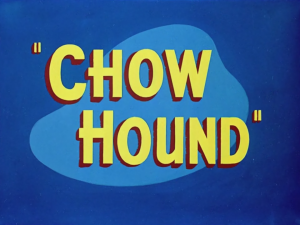 Chow Hound (Warner, 6/16/51 – Charles M. (Chuck) Jones, dir.) – A cult classic for fans of Jones’ best work, this film benefits greatly from the guest vocal work of one John T. Smith, possessor of a delightful bass voice, who became a go-to man for specialty and “tough” voices for at least two studios (providing the late voices for both Fox and Crow in their last three cartoons produced for UPA, as well as numerous other Warner voices, including construction worker Hercules in Homeless Hare and the similar drill sergeant in Forward March Hare, the Crusher in Bunny Hugged, Nasty Canasta in Drip-Along Daffy, and even the Vincent Price sound-alike scientist in Water Water Every Hare). Here, Smith plays another tough character – a brawny, menacing dog (who looks a bit like Charlie Dog on steroids), who throws his weight around as a means of intimidation/subjugation, maintaining two personal “slaves” to accomplish his own greedy ends. The dog’s only weakness and passion is food – particularly meat, of any kind. Having no master of his own to provide, the dog recruits the unwilling assistance of a weak-hearted cat and a frustrated mouse, who are forced to do his bidding. The cat is made to assume the role of pet at four different domiciles – of a suburban housewife, an average single male, an elderly old-timer, and of all places, a zoo! Alternating locales for each mealtime, the dog sends in the cat to obtain tasty dinners. Steak, roasts, and chickens. (I thought dogs were supposed to avoid poultry bones.) Only the cat never gets to eat any, and is forced to sneak away with the edibles and surrender them to the dog, who wolfs them down in vigorous chomps, then regularly complains to the cat, “What! No gravy!”, giving him an excuse to slap the cat around. For the old-timer, the dog uses the added help of a small mouse, whom he keeps trapped outside in a sardine can with a rock placed on top of its lid. The mouse is forced to allow himself to be dragged in by the tail in the cat’s mouth, to regularly demonstrate to the old man that “You earned your keep”.
Chow Hound (Warner, 6/16/51 – Charles M. (Chuck) Jones, dir.) – A cult classic for fans of Jones’ best work, this film benefits greatly from the guest vocal work of one John T. Smith, possessor of a delightful bass voice, who became a go-to man for specialty and “tough” voices for at least two studios (providing the late voices for both Fox and Crow in their last three cartoons produced for UPA, as well as numerous other Warner voices, including construction worker Hercules in Homeless Hare and the similar drill sergeant in Forward March Hare, the Crusher in Bunny Hugged, Nasty Canasta in Drip-Along Daffy, and even the Vincent Price sound-alike scientist in Water Water Every Hare). Here, Smith plays another tough character – a brawny, menacing dog (who looks a bit like Charlie Dog on steroids), who throws his weight around as a means of intimidation/subjugation, maintaining two personal “slaves” to accomplish his own greedy ends. The dog’s only weakness and passion is food – particularly meat, of any kind. Having no master of his own to provide, the dog recruits the unwilling assistance of a weak-hearted cat and a frustrated mouse, who are forced to do his bidding. The cat is made to assume the role of pet at four different domiciles – of a suburban housewife, an average single male, an elderly old-timer, and of all places, a zoo! Alternating locales for each mealtime, the dog sends in the cat to obtain tasty dinners. Steak, roasts, and chickens. (I thought dogs were supposed to avoid poultry bones.) Only the cat never gets to eat any, and is forced to sneak away with the edibles and surrender them to the dog, who wolfs them down in vigorous chomps, then regularly complains to the cat, “What! No gravy!”, giving him an excuse to slap the cat around. For the old-timer, the dog uses the added help of a small mouse, whom he keeps trapped outside in a sardine can with a rock placed on top of its lid. The mouse is forced to allow himself to be dragged in by the tail in the cat’s mouth, to regularly demonstrate to the old man that “You earned your keep”.
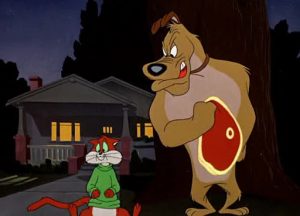 The mouse pleads to preserve his dignity, and even challenges in boxing position, stating, “Why don’cha fight me fair and square, ya bully?” The dog merely responds by tapping the mouse on the head with a small hammer, causing the mouse to respond in a daze, “I think a nap will do me a world of good”, collapsing and allowing the dog to seal him back inside the sardine can for convenient reuse next time. At the zoo, the cat resides in a cage, wearing a fake pair of dental fangs, behind a sign identifying him as a “sabre-toothed alley-cattus”. A puzzled zoo attendant nevertheless tosses him a steak as big as those of the lions and tigers. The cat tries a desperate means of escape from his never-ending cycle, by wrapping up a firecracker in the steak before the dog consumes it. But the dog is so tough, the explosion inside him is mistaken for only a burp, at which he states to the audience, “Pardon”. As the dog looks through his address book to remember which home is next in their repeating cycle, he becomes suddenly frustrated and displeased with his lot. “Week in, week out, it’s the same thing. It’s too slow. I gotta get more food.”, he shouts. Then, he spies a sign on the zoo grounds – “Reward offered for return of lost animals.” With a smiling sneer, the dog tells the cat, ‘I’ve got plans for you.”
The mouse pleads to preserve his dignity, and even challenges in boxing position, stating, “Why don’cha fight me fair and square, ya bully?” The dog merely responds by tapping the mouse on the head with a small hammer, causing the mouse to respond in a daze, “I think a nap will do me a world of good”, collapsing and allowing the dog to seal him back inside the sardine can for convenient reuse next time. At the zoo, the cat resides in a cage, wearing a fake pair of dental fangs, behind a sign identifying him as a “sabre-toothed alley-cattus”. A puzzled zoo attendant nevertheless tosses him a steak as big as those of the lions and tigers. The cat tries a desperate means of escape from his never-ending cycle, by wrapping up a firecracker in the steak before the dog consumes it. But the dog is so tough, the explosion inside him is mistaken for only a burp, at which he states to the audience, “Pardon”. As the dog looks through his address book to remember which home is next in their repeating cycle, he becomes suddenly frustrated and displeased with his lot. “Week in, week out, it’s the same thing. It’s too slow. I gotta get more food.”, he shouts. Then, he spies a sign on the zoo grounds – “Reward offered for return of lost animals.” With a smiling sneer, the dog tells the cat, ‘I’ve got plans for you.”
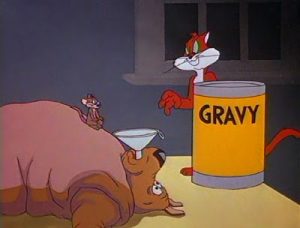 The next day, the cat fails to show up at any of the locations. The pet owners and zookeeper call and call for their lost charges, but receive no reply. The next day’s paper features four want-ads, one from each of the respective owners, offering large rewards. (One ad’s address refers to the studio nickname, “Termite Terrace”, while the zookeeper’s ad cleverly includes a self-reference to “C. M. Jones, Director”.) Reading the paper, the dog tells the cat, “This is the payoff.” He ties up the cat in a blanket bundle, delivering him to each of the anxious owners. But each box or basket with which he makes the deliveries comes equipped with a hatch door, through which the dog pulls the bundled cat out with a string after receiving each reward, to carry him off to the next destination. At the zoo, he makes the delivery in the disguise of a big game hunter, with the mouse forced to assist by carrying the bound cat while in the disguise of a blackfaced native bearer. “How mortifying”, the mouse appropriately notes. With four rewards in hand, the dog now believes himself set for life. He purchases a meat market. Jumping around like a child in a toy store,, as he stares at the sides of beef hanging everywhere, he cheers, “Acres and acres of meat. And they’re mine, ALL MINE!” The scene fades on this seemingly happy ending for a scoundrel. But justice will be served, as the camera fades in upon a dog and cat hospital. Inside, lying on his back on an examining table, lays the dog, every inch of his body so bloated to capacity, he is unable to move. “A sever case of overeating, doctor”, diagnoses one of the veterinarians. The consulting physicians leave the room, and the door to the examining room closes. After a brief pause, the doorknob turns again, and who should enter but the cat and mouse, with an evil grin upon their faces. Finally responding verbally to the dog’s repeated complaints throughout the cartoon, the cat completes the running gag, by stating, “This time we didn’t forget the gravy.” The dog begins to perspire profisely, whimpering, “No. No no!” But for him, there is no escape. The cat and mouse wheel in a 20 gallon cylinder of gravy, and a funnel. The mouse places the funnel in the helpless bulldog’s mouth, and the cat begins to pour the thick brown juices with vengeance, as the scene irises out in a perfect ending of ironic revenge.
The next day, the cat fails to show up at any of the locations. The pet owners and zookeeper call and call for their lost charges, but receive no reply. The next day’s paper features four want-ads, one from each of the respective owners, offering large rewards. (One ad’s address refers to the studio nickname, “Termite Terrace”, while the zookeeper’s ad cleverly includes a self-reference to “C. M. Jones, Director”.) Reading the paper, the dog tells the cat, “This is the payoff.” He ties up the cat in a blanket bundle, delivering him to each of the anxious owners. But each box or basket with which he makes the deliveries comes equipped with a hatch door, through which the dog pulls the bundled cat out with a string after receiving each reward, to carry him off to the next destination. At the zoo, he makes the delivery in the disguise of a big game hunter, with the mouse forced to assist by carrying the bound cat while in the disguise of a blackfaced native bearer. “How mortifying”, the mouse appropriately notes. With four rewards in hand, the dog now believes himself set for life. He purchases a meat market. Jumping around like a child in a toy store,, as he stares at the sides of beef hanging everywhere, he cheers, “Acres and acres of meat. And they’re mine, ALL MINE!” The scene fades on this seemingly happy ending for a scoundrel. But justice will be served, as the camera fades in upon a dog and cat hospital. Inside, lying on his back on an examining table, lays the dog, every inch of his body so bloated to capacity, he is unable to move. “A sever case of overeating, doctor”, diagnoses one of the veterinarians. The consulting physicians leave the room, and the door to the examining room closes. After a brief pause, the doorknob turns again, and who should enter but the cat and mouse, with an evil grin upon their faces. Finally responding verbally to the dog’s repeated complaints throughout the cartoon, the cat completes the running gag, by stating, “This time we didn’t forget the gravy.” The dog begins to perspire profisely, whimpering, “No. No no!” But for him, there is no escape. The cat and mouse wheel in a 20 gallon cylinder of gravy, and a funnel. The mouse places the funnel in the helpless bulldog’s mouth, and the cat begins to pour the thick brown juices with vengeance, as the scene irises out in a perfect ending of ironic revenge.
Here’s a clip:
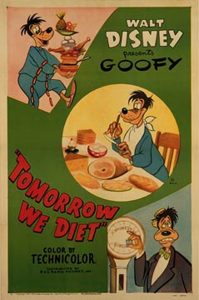 Tomorrow We Diet (Disney/RKO, Goofy, 6/29/51 – Jack Kinney, dir.) – Taking the opposite viewpoint from the previous “Goofy Gymnastics” reviewed last week, Goofy is depicted here not as a scrawny weakling needing building up, but as a 300 pound tub of lard, needing slimming down. One of s series of “vice” cartoons Kinney produced in the 1950’s, this one tackles the folly of overeating. Goof (or Geef, if you prefer) has a wall full of photos of his college days as an athlete, when he was slim and trim and the perfection of fitness. But Goof has let himself run down, and is seen in present day raiding the icebox for a full table of food, eating every last morsel down to the final olive. He waddles through a room with a huge bouncing belly, and passes a mirror, saying to his reflection, “Hello, handsome.” The reflection develops a life of its own, and sarcastically replies, “Hello, fat!” Shocked Goofy returns to the mirror. “Why “Im as fit as a fiddle.” He attempts to puff out his chest, assuming something of the silhouette of a violin. But his waistline drops, until his reflection laughs that he means “a bass fiddle.” Goof points to his old photos, boasting that he was an “all around athlete”. His reflection observes that now, he’s just “all round”.
Tomorrow We Diet (Disney/RKO, Goofy, 6/29/51 – Jack Kinney, dir.) – Taking the opposite viewpoint from the previous “Goofy Gymnastics” reviewed last week, Goofy is depicted here not as a scrawny weakling needing building up, but as a 300 pound tub of lard, needing slimming down. One of s series of “vice” cartoons Kinney produced in the 1950’s, this one tackles the folly of overeating. Goof (or Geef, if you prefer) has a wall full of photos of his college days as an athlete, when he was slim and trim and the perfection of fitness. But Goof has let himself run down, and is seen in present day raiding the icebox for a full table of food, eating every last morsel down to the final olive. He waddles through a room with a huge bouncing belly, and passes a mirror, saying to his reflection, “Hello, handsome.” The reflection develops a life of its own, and sarcastically replies, “Hello, fat!” Shocked Goofy returns to the mirror. “Why “Im as fit as a fiddle.” He attempts to puff out his chest, assuming something of the silhouette of a violin. But his waistline drops, until his reflection laughs that he means “a bass fiddle.” Goof points to his old photos, boasting that he was an “all around athlete”. His reflection observes that now, he’s just “all round”.
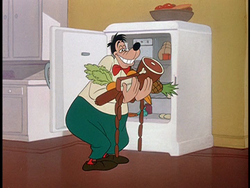 Attempting to get into his trousers, Goof’s pnnts bust a seam in the rear, leading to an unexpected trip to the tailor. To get enough material, the tailor climbs a ladder and removes the cloth of his awning from the store, producing from it a “slenderizing” striped suit for the Goof. Goof hails a taxi, but blows out all four tires from the weight of his climbing in. At a local diner, grabbing lunch while occupying two stools at the same time, Goofy is addressed by the cook, “Any more grub, chub?” Goofy next attempts to enter a building elevator – but the vehicle can’t rise off the ground floor under his weight. To satisfy his curiosity at these events, Goofy steps on a coin-operated weight scale. Goofy reads the fortune card: “You are jolly, genial, loveable, and – FAT AS A PIG??” Perhaps it is time for some desperate measures.
Attempting to get into his trousers, Goof’s pnnts bust a seam in the rear, leading to an unexpected trip to the tailor. To get enough material, the tailor climbs a ladder and removes the cloth of his awning from the store, producing from it a “slenderizing” striped suit for the Goof. Goof hails a taxi, but blows out all four tires from the weight of his climbing in. At a local diner, grabbing lunch while occupying two stools at the same time, Goofy is addressed by the cook, “Any more grub, chub?” Goofy next attempts to enter a building elevator – but the vehicle can’t rise off the ground floor under his weight. To satisfy his curiosity at these events, Goofy steps on a coin-operated weight scale. Goofy reads the fortune card: “You are jolly, genial, loveable, and – FAT AS A PIG??” Perhaps it is time for some desperate measures.
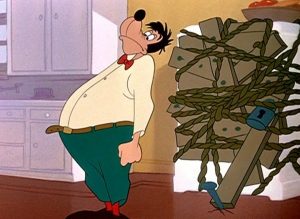 As we return to Goofy’s home, the independent reflection is seen cleaning the glass on his side of the mirror. Enter the Goof, concealing a book entitled “Easy Ways To Reduce”. “Bring it here, junior”, insists the reflection, who assumes the role of exercise coach, as he reads from a reflected copy inside the mirror. The reflection suggests an “easy” one for starters – touching his toes. “Toes?”, says Goofy, looking down and seeing nothing but his own wide waistline. “If you can’t see ‘em, you can’t touch ‘em”, sneers the reflection. Goof desperately strains and sttretches both his arms and legs in painful effort to make ends meet. His toes finally pop through his shoes, and contact is briefly made – until Goofy keels over backwards, rolling around on his back. The reflection concludes Goof’s trouble is food. The ,ere mention of the word sends Goofy instinctively to the refrigerator, setting out another banquet. “You can’t eat all that”, insists the reflection, itemizing the foods he can’t eat if he wants to lose weight. Goofy sadly pushes the no-no items away, until all that is left on the table is a single carrot. Goof briefly transforms into a rabbit, then sadly back to his old self. With nothing appetizing left on the plate, the reflection convinces Goofy to, better yet, merely push himself away from the table. But Goof can’t leave the hitchen without passing the ice box again, and is drawn backwards like a literal magnet for another load. “Get thee behind me, salami!”, shouts the reflection, shaming Goofy into replacing the food in its original position. The reflection tells him to get a hobby, and occupy his mind by reading. But the first magazine Goofy opens seems to have no content except for an endless supply of food ads. Then Goofy starts to notice the decor patterns he has set up around the house. Draperies depicting coldcuts. Upholstery with images of apples and bananas. And wallpaper depicting ham and eggs. A wall-mounted trout, and decorations on a lamp pole shaped like grapes. Goof’s eyes spin, as a voice inside him taunts him with the repeated echoing cry of “Eat. Eat.” A look out the window provides no better view, as the night sky is peppered with neon signs advertising countless local eateries. Goofy can find no peace, except to dive under the covers of his bed. “Stout fellow”, approves his reflection, who also beds down for the night, shutting the light to the room from inside his reflected world.
As we return to Goofy’s home, the independent reflection is seen cleaning the glass on his side of the mirror. Enter the Goof, concealing a book entitled “Easy Ways To Reduce”. “Bring it here, junior”, insists the reflection, who assumes the role of exercise coach, as he reads from a reflected copy inside the mirror. The reflection suggests an “easy” one for starters – touching his toes. “Toes?”, says Goofy, looking down and seeing nothing but his own wide waistline. “If you can’t see ‘em, you can’t touch ‘em”, sneers the reflection. Goof desperately strains and sttretches both his arms and legs in painful effort to make ends meet. His toes finally pop through his shoes, and contact is briefly made – until Goofy keels over backwards, rolling around on his back. The reflection concludes Goof’s trouble is food. The ,ere mention of the word sends Goofy instinctively to the refrigerator, setting out another banquet. “You can’t eat all that”, insists the reflection, itemizing the foods he can’t eat if he wants to lose weight. Goofy sadly pushes the no-no items away, until all that is left on the table is a single carrot. Goof briefly transforms into a rabbit, then sadly back to his old self. With nothing appetizing left on the plate, the reflection convinces Goofy to, better yet, merely push himself away from the table. But Goof can’t leave the hitchen without passing the ice box again, and is drawn backwards like a literal magnet for another load. “Get thee behind me, salami!”, shouts the reflection, shaming Goofy into replacing the food in its original position. The reflection tells him to get a hobby, and occupy his mind by reading. But the first magazine Goofy opens seems to have no content except for an endless supply of food ads. Then Goofy starts to notice the decor patterns he has set up around the house. Draperies depicting coldcuts. Upholstery with images of apples and bananas. And wallpaper depicting ham and eggs. A wall-mounted trout, and decorations on a lamp pole shaped like grapes. Goof’s eyes spin, as a voice inside him taunts him with the repeated echoing cry of “Eat. Eat.” A look out the window provides no better view, as the night sky is peppered with neon signs advertising countless local eateries. Goofy can find no peace, except to dive under the covers of his bed. “Stout fellow”, approves his reflection, who also beds down for the night, shutting the light to the room from inside his reflected world.
In the middle of the night, Goofy is roused from slumber by that gnawing feeling in his sttomach, and the equally-gnawing “Eat” call in his head. In a half-sleepwalk, he surrenders himself to the kitchen. However, upon peering into the icebox, he rises to full consciousness, finding its shelves to be completely empty. He suddenly hears the voice of his reflection, who, back in the bedroom, is seen just finishing up himself a tray of the refrigerator’s contents in the mirror, and who concludes, “Eat, drink, and be merry, and tomorrow, we diet.”
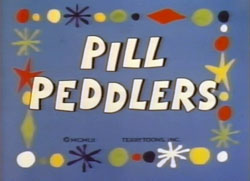 Pill Peddlers (Terrytoons/Fox, Heckle and Jeckle, 12/13/52 – Connie Rasinski, dir.) – Does the answer to fatness lie in the marvels of medicine and science? Or in good old-fashioned blood and sweat physical exertion? Based on this cartoon, we may never know. The “pro” side of the issue is presented in the form of a burly bulldog, owner of a “Body Building School” gymnasium with an active clientele rivaling Krazy Kat’s. While the bulldog instructor takes five in his office chair, his students labor at their respective improvement programs. A weak dog bats around a punching bag, only to have the bag punch back the minute he is through with it. Another dog appears to be performing wondrous feats on the exercise rings suspended from the ceiling, seen in closeup appearing to lift his whole weight with one finger. Actually, it’s quite easy, as the camera pulls back to reveal that the dog is so tall, his feet have never left the floor. An old Terrytoons gag is revisited with a pig on a rowing machine, bloating to expanded width on the forward rowing strokes, then retracting from the camera to become pencil thin on the backstrokes. The pig, however, is pooped, as it appears most of the other membership is getting. Enter the “con” side of the debate – and I do mean “con” – with the calls heard from outside the building of Heckle and Jeckle, engaged in a fast-talking pitch as sidewalk vendors of an alleged miracle pill that renders exercise obsolete. From their portable sales table expanded from a suitcase, they produce charts to pull down in front of scrawny passers-by, to illustrate the god-like physique they claim their pills can produce. Jeckle claims the pills are the cure for an “overextended pot”, demonstrating on an overweight dog by “molding” his flab by hand how he can push the fat upwards into his arms and allegedly “turn it into muscle”. Up in the gym, the pig sees this alternate cure-all as the road to easy street, and abandons his oars to hurry outside to make a purchase. The entire membership follows in droves, stampeding by the bulldog on their way out, spinning his swivel chair clean out of its base, and causing the center pole of the chair to drill a hole into the floor. The bulldog awakes with a start, surveying the premises, now totally empty. He determines to settle the score with the causers of this trouble. Heckle is engaged in another round of sales talk, with repeated touts of “Ya can’t go wrong”, and attempts to use another puny erson from the crowd as an example of the way exercise will only run you down.
Pill Peddlers (Terrytoons/Fox, Heckle and Jeckle, 12/13/52 – Connie Rasinski, dir.) – Does the answer to fatness lie in the marvels of medicine and science? Or in good old-fashioned blood and sweat physical exertion? Based on this cartoon, we may never know. The “pro” side of the issue is presented in the form of a burly bulldog, owner of a “Body Building School” gymnasium with an active clientele rivaling Krazy Kat’s. While the bulldog instructor takes five in his office chair, his students labor at their respective improvement programs. A weak dog bats around a punching bag, only to have the bag punch back the minute he is through with it. Another dog appears to be performing wondrous feats on the exercise rings suspended from the ceiling, seen in closeup appearing to lift his whole weight with one finger. Actually, it’s quite easy, as the camera pulls back to reveal that the dog is so tall, his feet have never left the floor. An old Terrytoons gag is revisited with a pig on a rowing machine, bloating to expanded width on the forward rowing strokes, then retracting from the camera to become pencil thin on the backstrokes. The pig, however, is pooped, as it appears most of the other membership is getting. Enter the “con” side of the debate – and I do mean “con” – with the calls heard from outside the building of Heckle and Jeckle, engaged in a fast-talking pitch as sidewalk vendors of an alleged miracle pill that renders exercise obsolete. From their portable sales table expanded from a suitcase, they produce charts to pull down in front of scrawny passers-by, to illustrate the god-like physique they claim their pills can produce. Jeckle claims the pills are the cure for an “overextended pot”, demonstrating on an overweight dog by “molding” his flab by hand how he can push the fat upwards into his arms and allegedly “turn it into muscle”. Up in the gym, the pig sees this alternate cure-all as the road to easy street, and abandons his oars to hurry outside to make a purchase. The entire membership follows in droves, stampeding by the bulldog on their way out, spinning his swivel chair clean out of its base, and causing the center pole of the chair to drill a hole into the floor. The bulldog awakes with a start, surveying the premises, now totally empty. He determines to settle the score with the causers of this trouble. Heckle is engaged in another round of sales talk, with repeated touts of “Ya can’t go wrong”, and attempts to use another puny erson from the crowd as an example of the way exercise will only run you down.
 The bird describes the subject as “knock-kneed and pigeon-toed, with arms like toothpicks and built like a bent hairpin.” Just then, the bulldog steps between Heckle and the little guy, unseen by the magpie. “Just look at that thing he calls a chest, folks!”, Heckle continues. His hand suddenly brushes against a medal pinned to the bulldog’s chest, which Heckle turns to read – “Champ?” Looking upwards, he spies the bulldog for the first time, breaks into an embarrassed grin, and begins to polish the medal respectfully. The bulldog advances, telling the birds to “Get outta here.” “I say, we can take a hint, you know”, says Jeckle, as the magpies grab their sales table and retreat around a corner. Thinking the job is done, the bulldog goes back inside. Not so fast, boy. From a basement elevator opening from a hatchway in the sidewak, the birds appear again, right back to their old spiel. The angry bulldog emerges, grabs the birds by the necks, and drags them both back inside the building. “Don’t go away, folks”, says Jeckle to the crowd outside, “We’ll be right back.” Heckle, on the other hand, is like a broken phonograph record, continuing in his sales-pitching without missing a beat, all the way upstairs and into the gymnasium, where he is still repeating the phrase to no one in particular, “Ya can’t go wrong.”
The bird describes the subject as “knock-kneed and pigeon-toed, with arms like toothpicks and built like a bent hairpin.” Just then, the bulldog steps between Heckle and the little guy, unseen by the magpie. “Just look at that thing he calls a chest, folks!”, Heckle continues. His hand suddenly brushes against a medal pinned to the bulldog’s chest, which Heckle turns to read – “Champ?” Looking upwards, he spies the bulldog for the first time, breaks into an embarrassed grin, and begins to polish the medal respectfully. The bulldog advances, telling the birds to “Get outta here.” “I say, we can take a hint, you know”, says Jeckle, as the magpies grab their sales table and retreat around a corner. Thinking the job is done, the bulldog goes back inside. Not so fast, boy. From a basement elevator opening from a hatchway in the sidewak, the birds appear again, right back to their old spiel. The angry bulldog emerges, grabs the birds by the necks, and drags them both back inside the building. “Don’t go away, folks”, says Jeckle to the crowd outside, “We’ll be right back.” Heckle, on the other hand, is like a broken phonograph record, continuing in his sales-pitching without missing a beat, all the way upstairs and into the gymnasium, where he is still repeating the phrase to no one in particular, “Ya can’t go wrong.”
The bulldog tosses the birds upon the floor, and demands that they prove their boasts. Pointing to a barbell, the bulldog commands, “Let’s see how good your pills are. Lift that.” As usual, the cunning magpies are calmly prepared for any situation. “It’s much too small”, insists Jeckle. “Get us a bigger one”, says Heckle. The dog obliges, sliding in a barbell with larger weights. “Bigger”, request the magpies. Larger and larger weights are pushed in, but the birds remain unsatisfied, until a barbell abour twenty times heavier than the first one is placed before them. “After you, chum”, quips Heckle, turning the tables. With Herculean strength, the dog struggles, strains, and succeeds in lifting the bar over his head. To add to his burden, the birds perch themselves on each of the two massive weights fastened to the bar. I say, he is strong, isn’t he”, observes Jeckle to Heckle. In a “lift” from “Goofy Gymnastics”, the birds’ added weight, like the fly on Goofy’s barbells, is too much for the flooring, and in a perspective shot looking down, the dog plummets five stories through a hole im the floor. True to their word, the birds quickly return to the crowd outside.
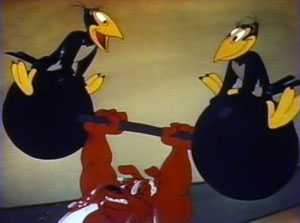 The bulldog, however, rejoins them, emerging from a manhole in the street from the sewer system under building. The trio run back inside, with the dog getting tangled up in a revolving door, from which he spins out looking like a triangular slice off a chocolate cake. By the time he makes it back upstairs, the birds seem to have disappeared. However, a matching set of dumbbells leaning against the wall include pairs of eyes and notable splashes of yellow on both ends. It is the magpies, with their beaks and feet curled up to match the shape of the other weights, creeping away to leave the bulldog feeling like the real dumbbell. The bulldog lifts a heavy steel weight, and hurls it at the magpies. It misses, landing on the forward end of a teeter-totter they are standing on. “Allez-oop”, says Jeckle in mid-air, as they are launched skyward, the two birds preparing themselves as if they are part of a circus acrobatic team. They land together back on the teeter-totter, flipping the metal weight backwards to land in the bulldog’s arms. Bowled over from the flying weight, the bulldog stumbles backwards, and is temporarily knocked unconscios, falling upon a massage table. Jeckle appears, wearing a chef’s hat, and reading from what appears to be a cookbook. “How to tenderize one tough bulldog”, he reads aloud. Heckle performs the culinary magic, as Jeckle instructs him to “Knead thoroughly, working with both hands back and forth. Then add a dash of liniment, six reducing pills, and sprinkle with talcum powder. Then turn over gently, and roll out until a nice gooey consistency.” The final step is to “place in a hot steambox and bake until well done.” Heckle again obliges, closing the steambox doors upon the dog and setting the heat indicator to “Phew!” The dog awakens, calling for help, until the steambox doors burst open, with the tried and true gag of the dog’s head remaining normal size, while his body is shrunken to a two-foot midget. He nevertheless resumes the chase after the birds, regaining his normal height as he runs.
The bulldog, however, rejoins them, emerging from a manhole in the street from the sewer system under building. The trio run back inside, with the dog getting tangled up in a revolving door, from which he spins out looking like a triangular slice off a chocolate cake. By the time he makes it back upstairs, the birds seem to have disappeared. However, a matching set of dumbbells leaning against the wall include pairs of eyes and notable splashes of yellow on both ends. It is the magpies, with their beaks and feet curled up to match the shape of the other weights, creeping away to leave the bulldog feeling like the real dumbbell. The bulldog lifts a heavy steel weight, and hurls it at the magpies. It misses, landing on the forward end of a teeter-totter they are standing on. “Allez-oop”, says Jeckle in mid-air, as they are launched skyward, the two birds preparing themselves as if they are part of a circus acrobatic team. They land together back on the teeter-totter, flipping the metal weight backwards to land in the bulldog’s arms. Bowled over from the flying weight, the bulldog stumbles backwards, and is temporarily knocked unconscios, falling upon a massage table. Jeckle appears, wearing a chef’s hat, and reading from what appears to be a cookbook. “How to tenderize one tough bulldog”, he reads aloud. Heckle performs the culinary magic, as Jeckle instructs him to “Knead thoroughly, working with both hands back and forth. Then add a dash of liniment, six reducing pills, and sprinkle with talcum powder. Then turn over gently, and roll out until a nice gooey consistency.” The final step is to “place in a hot steambox and bake until well done.” Heckle again obliges, closing the steambox doors upon the dog and setting the heat indicator to “Phew!” The dog awakens, calling for help, until the steambox doors burst open, with the tried and true gag of the dog’s head remaining normal size, while his body is shrunken to a two-foot midget. He nevertheless resumes the chase after the birds, regaining his normal height as he runs.
The finale chase takes place ouside the perimeters of the gymnasium, as the magpies dart into an elevator for the tower building, while the bulldog catches a second elevator in the next shaft. By way or only lights seen through the exterior windows of the tower, the camera follows the progress of the elevator cabs – defying all laws of physics and structural design by moving sideways, diagonally, back and forth – even crossing paths with each other’s directions of travel in rthe course of the pursuit. Inside their own cab, the magpies watch the light panel of buttons for the building’s floors – until the dot of light escapes the mounted bulbs of the panel altogether, descending past the panel until the dot falls to the floor of the cab. A curious Heckle opens the elevator door to see where they are – and finds himself staring into the face of the devil himself. “Opps. Too low!”, responds Heckle, slamming the door. With a push upon the panel, the elevator begins to rise again. Only this time, from the tower exterior view, we see the light of the bulldog’s cab is descending from directly above the magpies’ rising cab. A head-on collision between the two shatters the tower, hurling the magpies and bulldog into a vacant lot behind the tower. The dazed bulldog is still clutching to the operator’s handle of his elevator cab, now entirely disconnected from anything, and lapses into the dialogue of a department-store operator: “Secons floor. Women’s wear. Stockings. Girdles. Garter belts.” The magpies take this last opportunity to escape the situation the only way they know how – by climbing through the circle of the closing camera iris, appearing in front of the screen on the other side, as the Terrytoons logo and “The End” appear on the screen behind them. In a delightfully Avery-esque ending, lost to television for decades, Jeckle reacts to this information: “I say, we’re safe. It’s the end of the picture.” Striking a pose and preparing for the fade out, the birds are shocked when the screen bursts open behind them, and the bulldog reappears through the hole. “Not yet, it ain’t!” he barks, grabbing the two birds by the neck, and dragging them back into the vacant lot behind him. The background as seen through the hole erupts into a fight cloud. One of the birds tries to crawl back out the hole, and is again dragged back inside by the feet. Amidst verbal ad libs of “Ouch”, “You win”, and “We give up”, the pummeling and struggle finally die away, as the bulldog again appears at the hole, gives us a satisfied wink, and sweeps his hand around the tattered and folded edges of the torn screen, miraculously mending it shut, so that the end card can brigfly be read normally, allowing for the final fade out. Certainly one of the most clever Terrytoons to be produced from the 1950’s.
More fifties funniness when next we meet.


 Charles Gardner is an animation enthusiast who toils by day as a member of LA Law – but by nights and weekends indulges in classic jazz and ragtime as a performer; and studies classic Hollywood cartoons… maybe a little too much.
Charles Gardner is an animation enthusiast who toils by day as a member of LA Law – but by nights and weekends indulges in classic jazz and ragtime as a performer; and studies classic Hollywood cartoons… maybe a little too much.


































































































































































I always thought Robert McKImson directed Bye Bye Bluebeard and Holiday For Drumsticks. They both looked a lot like his style.
Looking forward to seeing your comments on McKImson’s The Muscle Tussle next week.
This is a great day — two Arthur Davis cartoons in the same post, including one that I’ve never seen before! I don’t like the placement of the comma in the title card of “Bye, Bye Bluebird”, but I love the cartoon!
The music that accompanies Porky’s dinner table calisthenics is the introduction to the “Kaiser-Walzer” (Emperor Waltz) by Johann Strauss the Younger. It was written to commemorate a meeting between Austrian Emperor Franz Joseph and German Emperor Wilhelm II, and since the German word “Kaiser” serves as both the singular and plural form of the noun, it could just as well be translated as “Emperors Waltz”, no apostrophe.
Among the bottles in Porky’s medicine cabinet are “Frizby Mixture”, “Maltese Minestrone”, “Ted Pierce’s Medicine”, “McKink’s Solution”, “Foster’s Panacea”, and “Jones Laxitive [sic]”.
“Gym Jam” may be the only Popeye cartoon where Olive wears a sailor suit, but Popeye and Bluto don’t.
“Hogan’s Alley” was a comic strip of the 1890s by Richard F. Outcault, one of the first printed in colour. The Yellow Kid, who later starred in his own strip, was originally a character in “Hogan’s Alley”. For a long time I assumed that the alley in Top Cat was named after Hoagy Carmichael, but then I thought the sandwich was, too.
The local roast chicken takeaway shop used to have a poster on the wall with the caption “Don’t forget the gravy!” under a picture of… Foghorn Leghorn??? I never found out if it was an allusion to “Chow Hound” or not; the overworked woman behind the counter was always so harried, I didn’t feel like asking about it.
Looking forward to next week’s workout!
Arthur Davis’ cartoons are some of my favorites.
He was a very underrated director.
The ending of “Chow Hound” is like something out of and EC Comics horror book.
A summary of any “Paddy the Pelican” episode is bound to tax the skills of any writer, but I’ll give it a go.
In “The Land of More” (Sam Singer/WEFN-TV [Chicago], The Adventures of Paddy the Pelican, 25/9/50 — Sam Singer, dir.), a chubby boy named Tom “Tubby” Round has bought a balloon that, alas, does not blow up as big as he had hoped it would. Suddenly a gnome magically appears and explains that Tubby has bought a magical wishing balloon, and so his wish for a larger balloon can be granted. The balloon swells up until it destroys Tubby’s house and floats away, with the hapless boy clinging to it. A bird pecks a hole in the balloon, causing it to fall to earth in the Land of More, a place that looks like a pencil test of the dream landscapes in “Somewhere in Dreamland” and “Butterscotch and Soda” with their endless vistas of cake, ice cream and other sweets.
The gnome, who is already there, tells Tubby that he can now indulge his appetite for more of everything. Tubby asks for a chocolate soda — but the glass is so big, he can’t get to the top of it. He asks for a piece of candy — but it’s too big to fit in his mouth. Feeling tired, he’s shown a giant bed — but the gnome says that if he lies down in it, he won’t wake up for a hundred years. Now disillusioned, Tubby tries to use the wishing balloon to wish himself back home — but the gnome explains that the balloon can only be used to wish for things in the Land of More, and his home isn’t there.
Tubby then patches up the balloon with a wad of gum, then wishes for a big parachute and a big gust of wind. The wind blows him far away from the Land of More, and the parachute enables him to land safely beside the ruins of his house. He blames the wishing balloon for the loss of his home, but the gnome tells him: “It’s your greediness that got you in trouble, Tom! Now you have one wish left. What’ll it be?” Tubby wishes for his home to be as it was, and just like that, it happens. “I’m going to get rid of the wishing balloon right now,” he says. “And after this, instead of wishing for more, I’m going to enjoy what I have!”
And where was Paddy while all this was going on? Off frolicking with Two Wet Bears, no doubt….
“Chow Hound” is probably my favorite cartoon–certainly my favorite one-shot. And yes, that “Tales From the Crypt” ending never fails to knock out an audience. Fun fact: The song played under the opening credits is “It’s a Great Feeling,” arguably one of the best ironic uses of a Doris Day song ever.
Regarding Chow Hound, I’ve always loved that the only words the cat says are ‘This time we didn’t forget the gravy!’ right at the end. Was that Mel Blanc voicing the cat?
In Pill Peddlers, the bulldog’s name is Clancy.